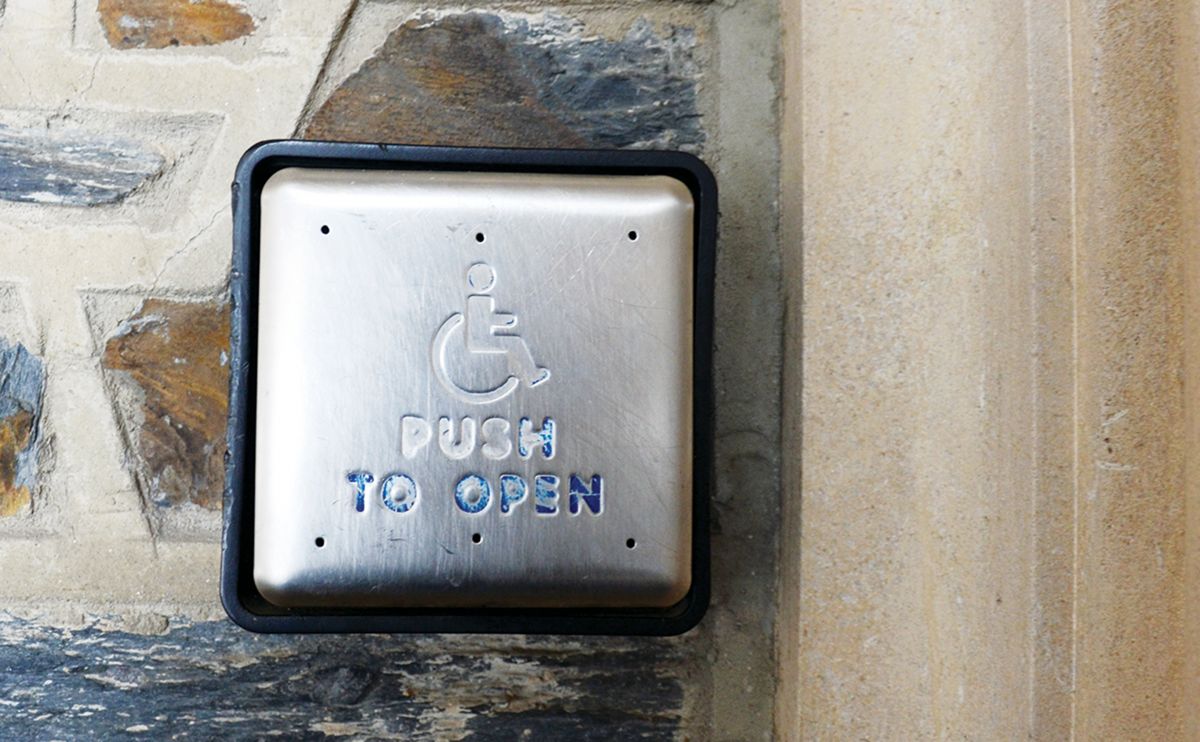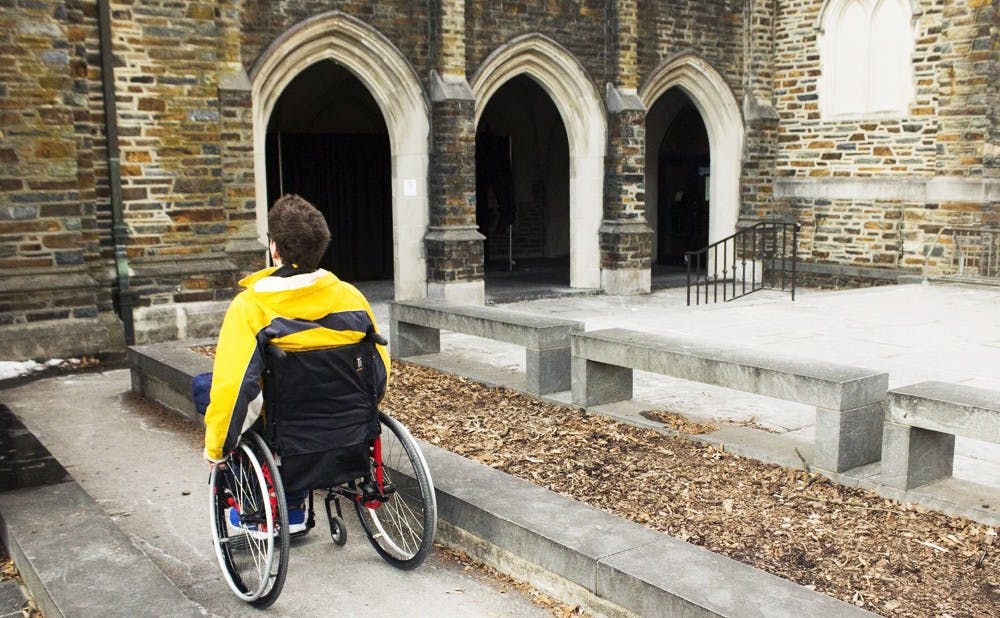Students often talk about struggling with the pressure to be the perfect Duke student. They talk about how the competitive environment pushes them to hide their weaknesses, appear put-together yet blasé and avoid vulnerability at all costs.
What students don’t talk about, however, is what happens when you inherently can’t meet these standards set by your peers.
For students like senior John Broadbent, whose type I Osteogenesis Imperfecta manifests in fragile muscle strength, spinal curvature and a speech impediment, these standards are impossible to attain from the get-go. Although some might see this as a vulnerability, Broadbent has discovered that his disability has liberated him from being tied to these pressures.
“I feel it’s a benefit that my disability is out in the open,” he said. “I don’t have to put on airs of perfection, especially at a place like Duke where conformity is often required.”
Although he may not strive for what Duke students have defined as “perfect,” Broadbent still has a clear sense of what he expects of himself.
“There are still certain standards that I set myself to,” he said. “And these standards are just as lofty as any one else’s.”
One can get a taste of Broadbent’s goal-driven persona in his involvement on campus. A classic civilizations major and art history minor, Broadbent previously worked with the Duke Classical Colloquia and is also in the marching band. During football season he plays the cymbals while during basketball season, he plays both the drum set and bass drum.
Broadbent admits, however, that he would not be where he is now without the help of the Student Disability Access Office, calling their role in his college experience absolutely crucial. The SDAO is part of the larger Duke Disability Management System, which provides leadership to the University and University Health System. The SDAO aims not only to provide convenient accommodations and services on campus for 315 students, but also to help them learn about and advocate for their rights and responsibilities as citizens.
Tucked away on Oregon Street near the Duke Police Station and the Ronald McDonald house, the SDAO is smaller than one would imagine, given their comprehensive services for undergraduate and graduate students.

“Duke is an incredibly able-bodied campus. You see people running, playing Frisbee on the quads and relaxing outside when the weather’s better,” DMS Executive Director Leigh Fickling said. “What you don’t see are people with disabilities doing the same thing. I’m always thinking about how to better integrate my students into campus activity.”
Students are required to self-disclose their disabilities if they seek accommodations on campus. Students complete a request form, which the office then collects and reviews to determine eligibility and type of accommodation. Every student is managed case by case: while two students might have the same disability, they could be given different accommodations.
Common accommodations include extended test time, minimally distracting environments for tests, assistant technology, note-takers and resident hall room modifications. Unlike many other schools, DMS also has its own Americans with Disabilities Act facilities program director, Dennis Novack, who responds to requests filled out by anyone online to ensure that the campus is accessible for everyone.
These developments and relationships are all part of a gradual improvement for the office. Senior Alex Kazandijan, who started his college career in a wheelchair, recalls how challenging his first week at Duke was.
“During move-in, I couldn’t actually get into my dorm, Pegram,” he said. “There’s a ramp out back, but I hadn’t been given swipe access, so that took a couple of days to fix.”
Kazandijan was also unable to make it to class during his first week due to the absence of an elevator at West Duke. Even after being moved to classes with access to elevators, his experiences inside of the elevators have been more than interesting.
“One time I felt like I was just in this broom closet,” he said. “There were brooms and dust pans everywhere. But the best was when there was a pile of coal. To this day, I don’t even know why, but there was just this pile of coal.”

With a staff of only eight members, the SDAO works each day to level the playing field on campus for 315 different undergraduate and graduate students with disabilities. Yet the ratio of staff to student hasn’t always been this staggeringly small.
In 2008, Congress passed an amendment for the ADA. This amendment expanded the definition of disabilities to include conditions such as psychological disorders, learning disabilities and chronic health disease, which led the SDAO to face an enormous increase in students who were eligible for their services.
Get The Chronicle straight to your inbox
Sign up for our weekly newsletter. Cancel at any time.
“Students who were seeking accommodations [before 2008] may not have been eligible for disability accommodations because their health conditions did not rise to the level of a disability,” Jenni Holt, student disability case management coordinator, said. “With the passing of the Amendments Act, we are seeing a huge increase in the number of eligible students.”
Two different types of students seek help from the SDAO, Fickling explained. There are students who have come to terms with their disability over time. Yet others fear that faculty and future employers who might view their disability as a potential stigma. So while 315 seems like an already overwhelming number, Fickling said more students may have eligible disabilities but are unwilling to seek help due to these insecurities.
“As much as I would want to walk up to someone with a visible limp or a hearing aid and ask if they need me, we need to rely on the students to come to us themselves,” Fickling said.

In order to bring students with disabilities together, Megan Barron, Trinity ’13, co-founded the Duke Disabilities Alliance. In addition to ensuring the enhancement of accessibility, she also realized during her sophomore year that dialogue on race, gender and sexuality had emerged at Duke, but the conversation concerning the disabled experience was absent.
“DDA was meant to be two-pronged,” Barron said. “We wanted it to be a student life organization that provided a space for students with disabilities to meet and hang out. We also wanted to provide a voice for the disabled to the administration and bring life to issues that were being unvoiced and unheard.”
Collaborating with different student groups such as Duke Student Government, DDA helped prioritize accessibility on campus. In 2012, Barron led a campus walk with sophomore Bryan Dinner, DSG senator of equity and outreach and current president of DDA, and DSG president Stefani Jones, a senior, to illustrate specifically what areas on campus needed improvement.
Although DDA provides a strong network for students with disabilities and helps to fill the gap that the SDAO cannot fill, students like Broadbent have opted not to join.
“I don’t want to be labeled by an organization for something that I can’t directly control,” Broadbent said. “I feel very strongly about advocating people with disabilities, but being in an organization that identifies itself with having been born with a disability doesn’t seem the most effective to me.”
Dinner, who is not disabled himself, chose to lead DDA this year because his experience working with Barron helped him see the importance of advocating for making campus an accessible and safe place for the disabled community.
“It’s a worthy cause and I don’t want to see all of the work accomplished by Barron last year go to waste,” Dinner said.

Administrative response has been phenomenal, said members at the SDAO. Given the students’ various disabilities and medical conditions, no two days are ever the same. They need administrators’ full support to meet all the needs and requests sent to the office.
“What you will find here that is also unique to Duke is that there is a strong commitment from the top-down to support students with disabilities,” Fickling said. “When you have the administration’s support, we are able to get more done more effectively.”
The SDAO works directly with Vice President of Administration Kyle Cavanaugh who also once worked as a special education teacher. Cavanaugh speaks every day to the administration about the challenges that students, visitors and staff with disabilities face, especially with the expansion of the definition of disability.
“We are marching honestly toward another crossroads in order to keep up the volume and probably will revisit the topic of resources,” he said. “One of the challenges is that you never know exactly what the volume and the type of situation you may be faced with.”
Despite these challenges, the SDAO’s increased presence has positively impacted the Duke community.
“The office serves as a positive catalyst and resource, but I also think it’s the entire Duke community,” Cavanugh said. “Our faculty, staff and other students have become more comfortable with this being a norm and are becoming more embracing of this.”
Broadbent also agreed that the SDAO was helping students with disabilities to carve out their experiences and identities at Duke, even if that means having to admit that their struggle is different than students without disabilities.
“It’s difficult to get a person to be open about their flaws, especially at Duke,” Broadbent said. “For someone with a disability to feel comfortable doing that just shows that the SDAO is a phenomenal resource willing to work through any problem.”
Talking about the disabled experience at Duke is difficult. It’s easy for the lines between respect, offense, political correctness and curiosity to become terribly blurred. Yet the SDAO has worked to improve the lives of the disabled community and help them have the full and complete experience of a Dukie, one small step at a time.
“I’ve definitely stopped seeing coal in the elevator,” Kazandijan said, chuckling at the memory. “I hope people next year can say the same.”

